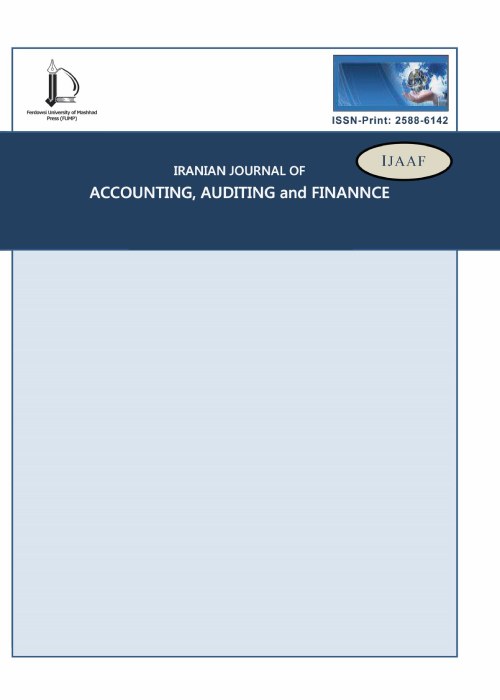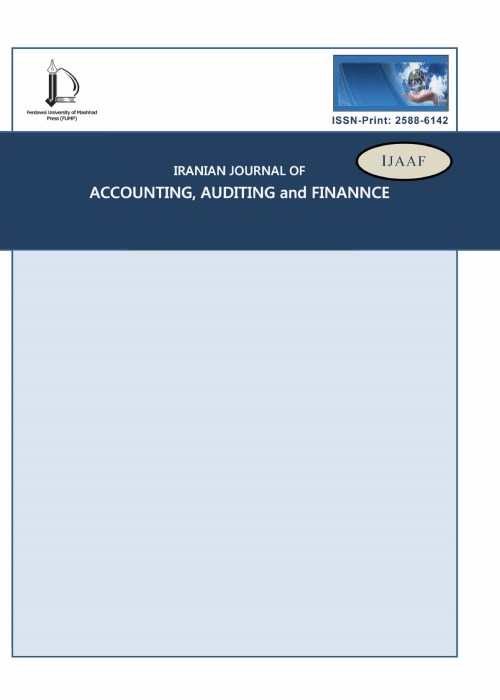فهرست مطالب

Iranian Journal of Accounting, Auditing and Finance
Volume:7 Issue: 3, Summer 2023
- تاریخ انتشار: 1402/05/10
- تعداد عناوین: 7
-
-
Pages 1-16Forming an investment portfolio is one of the main concerns of managers and investors who strive in order to create the best investment portfolio to get the best return from the market. So far, many methods have been presented to construct a portfolio, of which the most famous is the Markowitz approach. Our research aims to offer a classical portfolio selection using cluster analysis. We trained four models using k-means clustering with daily log returns as features and agglomerative clustering methods with complete, single and average linkages based on correlation-based distances. Four equally weighted portfolios of 30 stocks each were formed by selecting the stock with the highest Sharpe ratio from each cluster. Based on the silhouette scores and Sharpe ratio, we selected agglomerative clustering with average linkage trained on last year’s data as our final model. The performance of our selected portfolios over the test period was better than random selection in terms of Sharpe ratio but worse than the overall index. The results in terms of volatility showed better performance; our selected portfolio had an annualized volatility lower than the random selection and the average volatility of all clusters and relatively close to that of the equally weighted portfolio consisting of all 334 stocks in the data.Keywords: Hierarchical clustering, Portfolio optimization, Portfolio Diversification, K-means
-
Pages 17-37One of the competitive conflicts of the capital market is the structural disruption of companies in terms of company capacity with market changes that can lead to the bankruptcy of companies. Bankruptcy will usually have detrimental social effects and loss of stakeholder rights due to individual negligence and lack of strategic structural insights at the market level, that knowing that can prevent financial helplessness and bankruptcy and maintain the ground for growth or maintaining the competitive position of the company in the markets as well as the capital market. This study aims to design a model of intangible causes of bankruptcy of capital market companies based on modeling a Total Interpretive Structural Modelling. This research is methodologically based on the result, developmental, and data type is a mixed method. In the qualitative part of the research, through Meta-synthesis and Delphi analysis, an attempt was made to screen the themes of companies' bankruptcy in the capital market and then determine their theoretical adequacy based on Delphi analysis. In the quantitative part of the research, an attempt was made to prioritize the approved themes of the qualitative part while analyzing the total interpretive structural model to determine the most influential theme of the bankruptcy of capital market companies. The target population in this research in the qualitative part included 12 accounting and financial management specialists at the university level and in the quantitative part were 25 managers of the top 50 companies of the stock exchange. The results showed that the lack of strategies to reduce the size of the company based on the product life cycle of products is the most intangible factor in the bankruptcy of capital market companies. This research is limited because it focuses on companies' content and structural dimensions in creating bankruptcy risk. Based on a combination of qualitative and quantitative analysis, he sought to explain the dimensions identified in prioritizing the themes of bankruptcy of capital market companies, an area that, despite its strategic importance and institutional governance in protecting the interests of shareholders, has received less attention. This research can be used to develop theoretical foundations on the one hand and the structural and content relevance of companies on the other to surround the stimulus considered the risks of bankruptcy. The paper shapes the relationship between a firm's situation, its symptoms, the bankruptcy syndrome and the causes of a particular situation. Using one of the newest developed theories, total interpretive structural modelling (TISM) used in firms' diagnosis – the bankruptcy syndrome – the paper extends the characteristics of this term and uses it in determining the causes that generate anomalies at the firm level.Keywords: Content Causes of Corporate Bankruptcy, Structural Causes of Corporate Bankruptcy, Total Interpretive Structural Modelling
-
Pages 39-52
When human societies in science, industry and economics are constantly growing and developing, and the role of financial activities in any development is undeniable, the need for daily accounting development, especially the primary need in society, is felt. It becomes. The primary purpose of accrual accounting is to help users evaluate the economic performance of organizations over a certain period. This research is considered exploratory research in nature. Thus, the research data was compiled in 2020 using semi-structured interviews with experts, coded and analyzed by the researcher, and finally reached theoretical saturation. In addition, the content analysis method and the content network type have been used to analyze the data. The research findings showed the optimal model of the accrual accounting system in the public sector from four comprehensive themes: a) development of institutional trust in executive bodies, b) facilitation in the management process of executive bodies, c) efficient organizational productivity of executive bodies and d) the optimization of the financial rules and regulations of the executive apparatus identified nine organized themes and finally reached theoretical saturation with 43 basic themes. Among the research innovations are achieving social structures such as increasing accountability and responsibility, increasing the reliability of government performance and transparency of financial reports in the form of comprehensive content, and increasing institutional trust in the executive apparatus and managerial and structural structures.
Keywords: Accrual Accounting, Institutional trust, management process, organizational productivity, financial rules, regulations -
Pages 53-65The pricing of audit services has been a topic of interest to many audit researchers. In case auditors recognize managerial overconfidence, they are expected to incorporate this risk factor into their audit planning and compensate for additional audit efforts to reduce diagnostic risk. This research investigates the effect of the stakeholder equity mechanisms on the relationship between managerial overconfidence and abnormal audit fees. The research sample comprises 144 listed firms on the Tehran Stock Exchange (TSE) from 2012 to 2021. Multiple regression techniques are used to test hypotheses. Furthermore, the Burks et al. (2019) method of testing interaction role is applied. The capital expenditure ratio index has been used for measuring managerial overconfidence. The results indicated a positive and significant relationship between managerial overconfidence and abnormal fees for auditing services. Moreover, the stakeholder equity mechanisms undermine the relationship between managerial overconfidence and abnormal fee for auditing services.Keywords: Managerial overconfidence, Abnormal Fees, Stakeholder mechanisms
-
Pages 67-86The primary purpose of this study is to investigate the effect of COVID-19 on profitability and employee performance in state-owned and private banks in Iran. In other words, the present study seeks to find an answer to whether COVID-19 can affect the profitability and performance of employees of Iranian banks or not. In terms of objective, the study method is a practical and descriptive survey. The study's statistical population comprises all managers, staff, and customers of state-owned and private banks in Iran, through which 540 questionnaires were filled and analyzed. The sampling method of the study is available non-random that is used as the study's sample. In this paper, the PLS tests are employed to assess the effect of independent variables on the dependent ones. The results from the study's hypotheses show that COVID-19 has a positive and significant effect on profitability and employee performance. Moreover, the effect is more tangible in state-owned banks than the private ones. The present study was carried out in emergent financial markets, like Iran, which is highly competitive and suffering from severe economic sanctions since due to the sanctions, most countries, including the United States, did not allocate vaccines to the Iranian people and that exacerbated the conditions in Iran, it can provide the readers with useful information to develop science and knowledge in this field.Keywords: Employee Performance, Banks Profitability, Covid 19
-
Pages 87-103Sustainability is essential in human societies, and companies play an important role in recognizing and properly implementing corporate sustainability, including social, management and environmental dimensions. Mainly, in different companies, sustainability originates from the decisions of the managers of that organization or members of the board of directors and, in general, the ownership structure. The purpose of this research is to investigate the effect of the ownership structure of companies on corporate sustainability performance disclosure with the moderating role of the independent board of directors. For this purpose, 111 companies listed on the Tehran Stock Exchange from 2016 to 2020 have been used as a case study. In this research, multiple regression based on panel data was used. Examining the hypotheses indicates that the structure of family ownership, major ownership and state ownership is effective on the corporate sustainability performance disclosure in social, governance and environmental dimensions. Also, the results show that the independent board of directors adjusts the relationship between the family ownership structure and major shareholders by disclosing the sustainability performance of the companies in environmental, social and governance dimensions. In case, the independent board of directors had no significant moderating effect on the relationship between state ownership and corporate sustainability performance disclosure.Keywords: Ownership Structure, Corporate Sustainability Performance Disclosure, Board Independence
-
Pages 105-115This study explores the primary factors influencing the number of analysts following a firm. The research sample comprises 11,459 non-U.S. firms, followed by various unique analysts during 2019 and 2020. The study proposes a straightforward model of analyst following, identifying several firm characteristics likely to affect the aggregate demand or supply of analyst services for a particular firm. A regression model tests the relationship between analyst following and high-technology firms (as proxied by R&D expenses) and firm size. The results reveal that, in the following year, analysts are more inclined to follow firms with a higher volume of R&D expenses and larger size in the current year. The study also uncovers that most control variables regarding firm characteristics significantly affect analyst following. In summary, the empirical results are consistent with economic intuition.Keywords: financial analysts, Firms’ Coverage, R&D, Size


